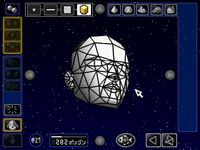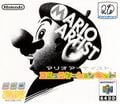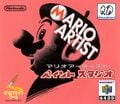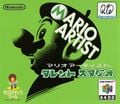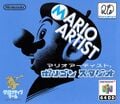Mario Artist (series): Difference between revisions
Wario W. 97 (talk | contribs) No edit summary |
Wario W. 97 (talk | contribs) No edit summary |
||
| Line 19: | Line 19: | ||
===''Mario Artist: Polygon Studio''=== | ===''Mario Artist: Polygon Studio''=== | ||
[[File:MAPS Polygonedit.png|thumb|Editing a face polygon in ''Mario Artist: Polygon Studio''.]] | [[File:MAPS Polygonedit.png|thumb|Editing a face polygon in ''Mario Artist: Polygon Studio''.]] | ||
''[[Mario Artist: Polygon Studio]]'' (rel. Aug. 29, 2000) allows users to construct and render 3-dimensional polygons, as the name suggests. This was the last Mario Artist game released. The game includes a special mode called '''Sound Bomber''' (サウンド ボンバ- ''Saundo Bonbā''), where the player has to win as many [[microgame]]s as possible, all of them featuring the player's polygon model in some way. This mode is the precursor to the ''[[WarioWare, Inc.|WarioWare]]'' series. | ''[[Mario Artist: Polygon Studio]]'' (rel. Aug. 29, 2000 in collabration with Nichimen Group) allows users to construct and render 3-dimensional polygons, as the name suggests. This was the last Mario Artist game released. The game includes a special mode called '''Sound Bomber''' (サウンド ボンバ- ''Saundo Bonbā''), where the player has to win as many [[microgame]]s as possible, all of them featuring the player's polygon model in some way. This mode is the precursor to the ''[[WarioWare, Inc.|WarioWare]]'' series. | ||
{{br}} | {{br}} | ||
Revision as of 11:13, September 29, 2016
It has been requested that this article be rewritten and expanded to include more information.
Mario Artist is a series of four games for the Nintendo 64DD, released in Japan only. Originally, eight games in total were announced, but four of them were cancelled due to the failure of the 64DD.
Games
Mario Artist: Paint Studio
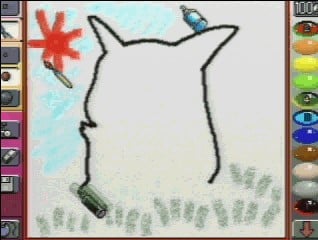
Mario Artist: Paint Studio (rel. Dec 11, 1999) is similar to Mario Paint, but with more features. It was one of only two launch titles for the 64DD. Images could be imported from video tape or a Game Boy Camera using the Nintendo 64 Capture Cartridge. It also came with a unique four player drawing mode where four players could collaborate to make one drawing together.
This game often came bundled with the Nintendo 64 Mouse.
Mario Artist: Talent Studio
Mario Artist: Talent Studio (rel. Feb. 23, 2000) allows users to insert pictures from cameras and videos onto 3-dimensional models, and then animate the models. Also, using the Capture Cartridge, which this game was bundled with, movies could be recorded by running a video camera through the Capture Cartridge. Also, The concept of a personal avatar creator app as is seen in today's Mii, is seen in Mario Artist: Talent Studio. Those avatars can be imported into the completely separate 64DD game, SimCity 64. Nintendo designer Yamashita Takayuki attributes his work on Talent Studio as having been foundational to his eventual work on the Mii.
Mario Artist: Communication Kit
Mario Artist: Communication Kit (rel. June 29, 2000) was an accessory to the other Mario Artist games. It allowed users to connect to Randnet's Net Studio, so users could share their creations in the other Mario Artist games with others. The RandNet only ran for little over a year.
Mario Artist: Polygon Studio
Mario Artist: Polygon Studio (rel. Aug. 29, 2000 in collabration with Nichimen Group) allows users to construct and render 3-dimensional polygons, as the name suggests. This was the last Mario Artist game released. The game includes a special mode called Sound Bomber (サウンド ボンバ- Saundo Bonbā), where the player has to win as many microgames as possible, all of them featuring the player's polygon model in some way. This mode is the precursor to the WarioWare series.
Cancelled games
- Mario Artist: Game Maker
- Mario Artist: Graphical Message Maker
- Mario Artist: Sound Maker
- Mario Artist: Video Jockey Maker
References to other games
- Mario Paint: The two man doing situp appear after pressing start in the title screen.
References in later games
- WarioWare series: Sound Bomber mode of Polygon Studio is the precursor to this series.
- Super Mario Maker: The music which plays in a menu of Polygon Studio called [ブロツクさくひん] (Block Work) is used for Coursebot, with some slight changes.[1]
Gallery
Box Art
Screenshots
- CREATOR 20PIC 2001.JPG
- 08MA.JPG
- 05MA.JPG
- 04MA.JPG
- 2creat.jpg
- MACC1.jpg
References
- ^ https://www.youtube.com/watch?v=psp1PK1yFd4 The music plays from 3:35
Template:BoxTop Template:Mariogames Template:UnreleasedMedia
